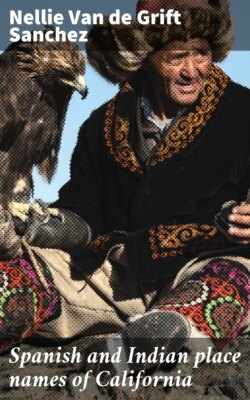Читать книгу Spanish and Indian place names of California - Nellie van de Grift Sanchez - Страница 17
На сайте Литреса книга снята с продажи.
SANTA CATALINA
ОглавлениеTable of Contents
Santa Catalina, the beautiful island off the coast of Southern California, was named by Vizcaíno in honor of St. Catherine, because its discovery occurred on the eve of her feast day, November 24, 1602. In the diary of the voyage we get an interesting description of the island and its aboriginal inhabitants: “We continued our journey along the coast until November 24, when, on the eve of the glorious Santa Catalina, we discovered three large islands; we took the one in the middle, which is more than twenty-five leagues in circumference, on November 27, and before dropping anchor in a good cove which was found, a great number of Indians came out in canoes of cedar-wood and pine, made of planking well-joined and calked, and with eight oars each, and fourteen or fifteen Indians, who looked like galley-slaves. They drew near and came on board our vessels without any fear whatever. We dropped anchor and went on shore. There were on the beach a great number of Indians, and the women received us with roasted sardines and a fruit cooked in the manner of sweet potatoes.”
Mass was celebrated there in the presence of 150 Indians. The people were very friendly and the women led the white men by the hand into their houses. The diary continues: “These people go dressed in the skins of seals; the women are modest but thievish. The Indians received us with embraces and brought water in some very well-made jars, and in others like flasks, that were highly varnished on the outside. They have acorns and some very large skins, with long wool, apparently of bears, which serve them for blankets.”
The travelers found here an idol, “in the manner of the devil, without a head, but with two horns, a dog at the feet, and many children painted around it.” The Indians readily gave up this idol and accepted the cross in its stead.
St. Catherine, patroness of this island, was one of the most notable female martyrs of the Roman Catholic church. We are told that she was of royal blood, being the daughter of a half-brother of Constantine the Great. She was converted to Christianity, and became noted for her unusual sanctity. She was both beautiful and intellectual, and possessed the gift of eloquence in such a high degree that she was able to confound fifty of the most learned men appointed by Maximin to dispute matters of religion with her. The same Maximin, enraged by her refusal of his offers of love, ordered that she be tortured “by wheels flying in different directions, to tear her to pieces. When they had bound her to these, an angel came and consumed the wheels in fire, and the fragments flew around and killed the executioners and 3000 people. Maximin finally caused her to be beheaded, when angels came and bore her body to the top of Mt. Sinai. In the eighth century a monastery was built over her burial place.”—(Stories of the Saints.) Santa Catalina is the patroness of education, science, philosophy, eloquence, and of all colleges, and her island has good reason to be satisfied with the name chosen by Vizcaíno.
